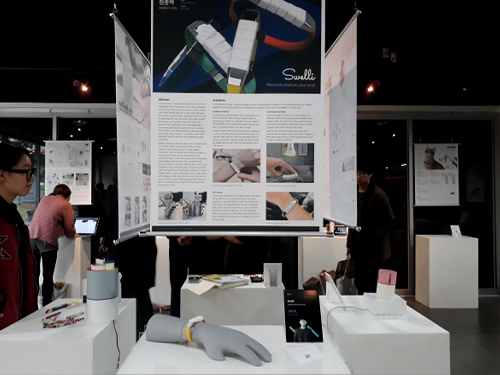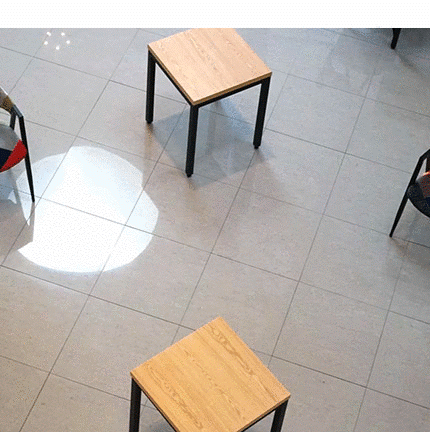Daniel+Saakes
-
 IDKAIST Graduation Show, Interative and Innovative Works
Undergraduate students from the Department of Industrial Design at KAIST opened up their graduation show in the Industrial Design Building for eight days in KAIST from November 10 and another four days in Coex, Seoul from December 7.
The students showcased their creative and novel works in the exhibition. Some designs successfully showed change concepts such as for mixing straws. There were also several projects designed to meet individual demand, such as a customized shoe-making application and personal makeup colorings.
Since the establishment of its undergraduate program in 1983, the department has held a graduation show to demonstrate four years of the students’ academic work and research performance to KAIST members, externals specialists, and the public.
Professor Daniel Saakes, who is in charge of the show, said, “Please come by the show and support the 28 students for their hard work. This year, students’ projects are more socially-oriented through applications and social media, making them easily approachable for consumers.”
2017.11.13 View 7838
IDKAIST Graduation Show, Interative and Innovative Works
Undergraduate students from the Department of Industrial Design at KAIST opened up their graduation show in the Industrial Design Building for eight days in KAIST from November 10 and another four days in Coex, Seoul from December 7.
The students showcased their creative and novel works in the exhibition. Some designs successfully showed change concepts such as for mixing straws. There were also several projects designed to meet individual demand, such as a customized shoe-making application and personal makeup colorings.
Since the establishment of its undergraduate program in 1983, the department has held a graduation show to demonstrate four years of the students’ academic work and research performance to KAIST members, externals specialists, and the public.
Professor Daniel Saakes, who is in charge of the show, said, “Please come by the show and support the 28 students for their hard work. This year, students’ projects are more socially-oriented through applications and social media, making them easily approachable for consumers.”
2017.11.13 View 7838 -
 Furniture That Learns to Move by Itself
A novel strategy for displacing large objects by attaching relatively small vibration sources. After learning how several random bursts of vibration affect an object's pose, an optimization algorithm discovers the optimal sequence of vibration patterns required to (slowly but surely) move the object to a specified position. Displacements of large objects induced by vibration are a common occurrence, but generally result in unpredictable motion. Think, for instance, of an unbalanced front-loading washing machine. For controlled movement, wheels or legs are usually preferred.
Professor Daniel Saakes of the Department of Industrial Design and his team explored a strategy for moving everyday objects by harvesting external vibration rather than using a mechanical system with wheels. This principle may be useful for displacing large objects in situations where attaching wheels or complete lifting is impossible – assuming the speed of the process is not a concern.
His team designed vibration modules that can be easily attached to furniture and objects, and this could be a welcomed creation for people with limited mobility, including the elderly. Embedding these vibration modules as part of mass-produced objects may provide a low-cost way to make almost any object mobile.
Vibration as a principle for directed locomotion has been previously applied in micro-robots. For instance, the three-legged Kilobots move thanks to centrifugal forces alternatively generated by a pair of vibrations on two of its legs. The unbalanced weight transforms the robot into a ratchet and the resulting motion is deterministic with respect to the input vibration. To the best of our knowledge, we are the first to add vibratory actuators to deterministically steer large objects regardless of their structural properties.
The perturbation resulting from a particular pattern of vibration depends on a myriad of parameters, including but not limited to the microscopic properties of the contact surfaces. The key challenge is to empirically discover and select the sequence of vibration patterns to bring the object to the target pose.
Their approach is as follows. In the first step we systematically explore the object’s response by manipulating the amplitudes of the motors. This generates a pool of available moves (translations and rotations). We then calculate from this pool the most efficient way (either in terms of length or number of moves) to go from pose A to pose B using optimization strategies, such as genetic algorithms. The learning process may be repeated from time to time to account for changes in the mechanical response, at least for the patterns of vibration that contribute more to the change.
Prototype modules are made with eccentric rotating motors (type 345-002 Precision Microdrive) with a nominal force of 115g, which proved sufficient to shake (and eventually locomote) four-legged IKEA chairs and small furniture such as tables and stools. The motors are powered by NiMH batteries and communicate wirelessly with a low-cost ESP8266 WiFi module. The team designed modules that are externally attached using straps as well as motors embedded in furniture.
To study the general method, the team employed an overhead camera to track the chair and generate the pool of available moves. The team demonstrated that the system discovered pivot-like gaits and others. However, as one can imagine, using a pre-computed sequence to move to a target pose does not end up providing perfect matches. This is because the contact properties vary with location. Although this can be considered a secondary disturbance, it may in certain cases be mandatory to recompute the matrix of moves every now and then. The chair could, for instance, move into a wet area, over plastic carpet, etc.
The principle and application in furniture is called “ratchair” as a portmanteau combining “Ratchet” and “Chair”. Ratchair was demonstrated at the 2016 ACM Siggraph Emerging Technologies and won the DC-EXPO award jointly organized by the Japanese Ministry of Economy, Trade and Industry (METI) and the Digital Content Association of Japan (DCAJ). At the DCEXPO Exhibition, Fall 2016, the work was one of 20 Innovative Technologies and the only non-Japanese contribution.
*This article is from the KAIST Breakthroughs, research newsletter from the College of Engineering.
For more stories of the KAIST Breakthroughs, please visit http://breakthroughs.kaist.ac.kr
http://mid.kaist.ac.kr/projects/ratchair/
http://s2016.siggraph.org/content/emerging-technologies
https://www.dcexpo.jp/ko/15184
Figure 1. The vibration modules embedded and attached to furniture.
Figure 2. A close-up of the vibration module.
Figure 3. A close-up of the embedded modules.
Figure 4. A close-up of the vibration motor.
2017.03.23 View 10225
Furniture That Learns to Move by Itself
A novel strategy for displacing large objects by attaching relatively small vibration sources. After learning how several random bursts of vibration affect an object's pose, an optimization algorithm discovers the optimal sequence of vibration patterns required to (slowly but surely) move the object to a specified position. Displacements of large objects induced by vibration are a common occurrence, but generally result in unpredictable motion. Think, for instance, of an unbalanced front-loading washing machine. For controlled movement, wheels or legs are usually preferred.
Professor Daniel Saakes of the Department of Industrial Design and his team explored a strategy for moving everyday objects by harvesting external vibration rather than using a mechanical system with wheels. This principle may be useful for displacing large objects in situations where attaching wheels or complete lifting is impossible – assuming the speed of the process is not a concern.
His team designed vibration modules that can be easily attached to furniture and objects, and this could be a welcomed creation for people with limited mobility, including the elderly. Embedding these vibration modules as part of mass-produced objects may provide a low-cost way to make almost any object mobile.
Vibration as a principle for directed locomotion has been previously applied in micro-robots. For instance, the three-legged Kilobots move thanks to centrifugal forces alternatively generated by a pair of vibrations on two of its legs. The unbalanced weight transforms the robot into a ratchet and the resulting motion is deterministic with respect to the input vibration. To the best of our knowledge, we are the first to add vibratory actuators to deterministically steer large objects regardless of their structural properties.
The perturbation resulting from a particular pattern of vibration depends on a myriad of parameters, including but not limited to the microscopic properties of the contact surfaces. The key challenge is to empirically discover and select the sequence of vibration patterns to bring the object to the target pose.
Their approach is as follows. In the first step we systematically explore the object’s response by manipulating the amplitudes of the motors. This generates a pool of available moves (translations and rotations). We then calculate from this pool the most efficient way (either in terms of length or number of moves) to go from pose A to pose B using optimization strategies, such as genetic algorithms. The learning process may be repeated from time to time to account for changes in the mechanical response, at least for the patterns of vibration that contribute more to the change.
Prototype modules are made with eccentric rotating motors (type 345-002 Precision Microdrive) with a nominal force of 115g, which proved sufficient to shake (and eventually locomote) four-legged IKEA chairs and small furniture such as tables and stools. The motors are powered by NiMH batteries and communicate wirelessly with a low-cost ESP8266 WiFi module. The team designed modules that are externally attached using straps as well as motors embedded in furniture.
To study the general method, the team employed an overhead camera to track the chair and generate the pool of available moves. The team demonstrated that the system discovered pivot-like gaits and others. However, as one can imagine, using a pre-computed sequence to move to a target pose does not end up providing perfect matches. This is because the contact properties vary with location. Although this can be considered a secondary disturbance, it may in certain cases be mandatory to recompute the matrix of moves every now and then. The chair could, for instance, move into a wet area, over plastic carpet, etc.
The principle and application in furniture is called “ratchair” as a portmanteau combining “Ratchet” and “Chair”. Ratchair was demonstrated at the 2016 ACM Siggraph Emerging Technologies and won the DC-EXPO award jointly organized by the Japanese Ministry of Economy, Trade and Industry (METI) and the Digital Content Association of Japan (DCAJ). At the DCEXPO Exhibition, Fall 2016, the work was one of 20 Innovative Technologies and the only non-Japanese contribution.
*This article is from the KAIST Breakthroughs, research newsletter from the College of Engineering.
For more stories of the KAIST Breakthroughs, please visit http://breakthroughs.kaist.ac.kr
http://mid.kaist.ac.kr/projects/ratchair/
http://s2016.siggraph.org/content/emerging-technologies
https://www.dcexpo.jp/ko/15184
Figure 1. The vibration modules embedded and attached to furniture.
Figure 2. A close-up of the vibration module.
Figure 3. A close-up of the embedded modules.
Figure 4. A close-up of the vibration motor.
2017.03.23 View 10225